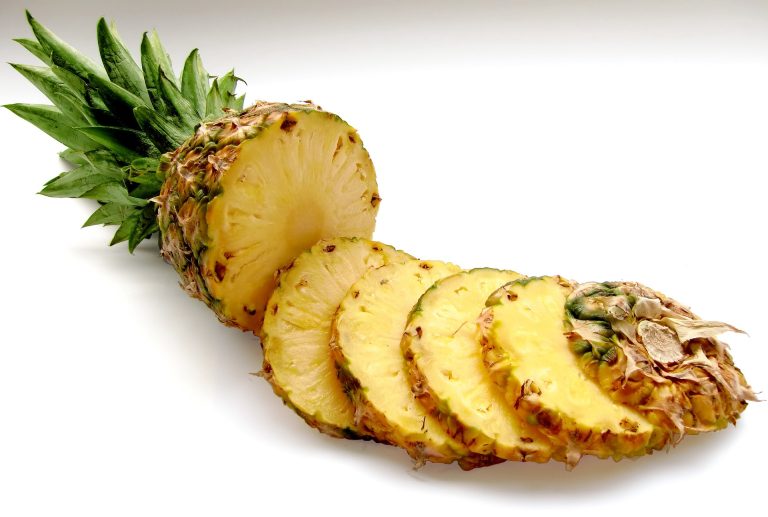Introduction
The pineapple, scientifically known as Ananas comosus, is not just a fruit but a symbol of tropical delight and hospitality worldwide. Its journey from its humble beginnings in South America to becoming a global agricultural and culinary phenomenon is a testament to human curiosity, exploration, and innovation. This article delves deep into the history, cultivation, nutritional benefits, cultural significance, and economic impact of the pineapple, highlighting its evolution from a local delicacy to a universally cherished fruit.

Historical Origins and Spread
The origins of the pineapple trace back to the tropical regions of South America, specifically to the Paraguay-Brazil border, where indigenous peoples cultivated it as early as 2500 BCE. Known to the Tupi-Guarani tribes as “nanas,” meaning excellent fruit, the pineapple held both nutritional and symbolic value in their culture. It was not just a source of food but also featured in religious ceremonies and as a gift of hospitality.
European Encounter and Expansion
The first European encounter with the pineapple occurred during Christopher Columbus’s second voyage to the Caribbean in 1493. Initially encountered by Spanish explorers, who brought it back to Europe, the pineapple quickly gained popularity among European elites as a symbol of luxury and exoticism. Its rarity and unique appearance made it a coveted item among the aristocracy, often depicted in art and heraldry as a sign of wealth and hospitality.

Cultivation and Commercialization
The commercial cultivation of pineapples began in earnest during the 17th century in the Caribbean, particularly in the island of Guadeloupe. The fruit’s ability to thrive in tropical climates and its relatively low maintenance requirements contributed to its rapid spread across the Caribbean islands and into Central America. However, it was the Dutch who established the first pineapple plantations in the Americas, particularly in Suriname and Guyana, where they began large-scale cultivation for export to Europe.
The Pineapple in Hawaii
One of the most significant chapters in pineapple history unfolded in Hawaii during the 19th century. Introduced to the islands by Spanish and English explorers, the pineapple found a particularly fertile environment in Hawaii’s volcanic soil and subtropical climate. Entrepreneurs like James Dole played a pivotal role in establishing Hawaii as a global leader in pineapple production. Dole’s Hawaiian Pineapple Company, later known as Dole Food Company, revolutionized pineapple farming with large-scale plantations and innovative canning techniques, which allowed for widespread distribution across the United States and beyond.

Nutritional Value and Health Benefits
Beyond its historical and cultural significance, the pineapple boasts an impressive array of nutritional benefits. Rich in vitamins, minerals, and enzymes such as bromelain, pineapples are celebrated for their anti-inflammatory properties and digestive health benefits. Bromelain, in particular, has been studied for its potential to reduce inflammation, aid in digestion, and even enhance wound healing. Moreover, pineapples are low in calories yet high in fiber, making them a popular choice for those seeking to maintain a healthy diet.
Culinary Delights and Versatility
In the culinary world, pineapples are revered for their versatility and vibrant flavor profile. Whether enjoyed fresh, grilled, juiced, or incorporated into dishes ranging from savory to sweet, pineapples add a tropical flair to countless recipes. From refreshing fruit salads and cocktails to savory dishes like Hawaiian pizza and grilled kebabs, the pineapple’s sweet-tart flavor and juicy texture make it a favorite ingredient in kitchens worldwide.
Cultural Symbolism and Traditions
Across various cultures, the pineapple has acquired symbolic meanings that transcend its culinary appeal. In many tropical regions, it remains a symbol of hospitality, warmth, and friendship—a tradition dating back centuries to indigenous practices of offering pineapple as a gesture of welcome. In Western societies, the pineapple continues to be associated with hospitality and a warm welcome, often seen in architectural motifs, interior design, and as a decorative element in homes.
Economic Impact and Global Trade
The global pineapple industry represents a significant economic force, with major producers including Costa Rica, the Philippines, Thailand, and India. Pineapple exports contribute substantially to the economies of these countries, providing employment opportunities and income for thousands of people involved in cultivation, harvesting, and processing. The fruit’s popularity in international markets, driven by its year-round availability and diverse applications, ensures a steady demand and economic stability for producing regions.

Environmental Considerations and Sustainability
While pineapple cultivation has brought economic benefits to many regions, it also poses environmental challenges, particularly concerning land use, water consumption, and pesticide use. Sustainable farming practices, including integrated pest management and soil conservation techniques, are increasingly being adopted to minimize environmental impact. Moreover, initiatives promoting fair trade and ethical sourcing aim to improve working conditions for pineapple farmers and ensure a more sustainable supply chain.
Future Trends and Innovations
Looking ahead, the pineapple industry is poised for further innovation and growth. Advances in agricultural technology, including genetic research and crop management techniques, promise to enhance yield, quality, and resistance to diseases. Consumer demand for organic and sustainably sourced pineapples continues to rise, prompting producers to adopt eco-friendly practices and certifications. Moreover, the development of new pineapple varieties with enhanced flavor profiles and nutritional benefits holds promise for expanding market opportunities and consumer preferences.
Conclusion
In conclusion, the pineapple stands not only as a delicious fruit but also as a symbol of human ingenuity, exploration, and cultural exchange. From its origins in the jungles of South America to its global presence today, the pineapple’s journey reflects centuries of trade, innovation, and adaptation. As we continue to appreciate its nutritional benefits, culinary versatility, and cultural significance, the pineapple remains a cherished fruit that connects people across continents and generations.

